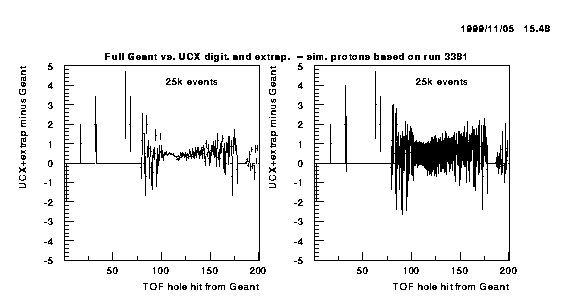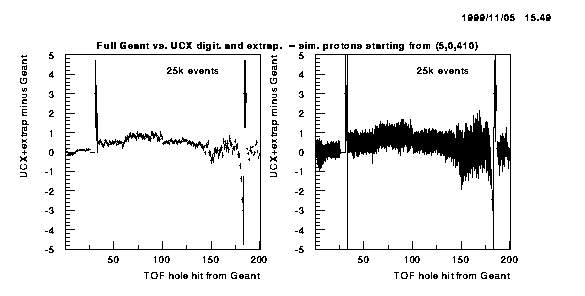
To produce the data in the second set, simulated protons were launched from a single point in the DDC ( (x, y, z) = (5, 0, 410) ). Their momentum distribution was uniform, varying from 2 GeV/c to 6 GeV/c. As for their trajectory, their angle in the xz-plane ranged uniformly from -15 degrees to 45 degrees. This provided full coverage over the TOF array. About 19k events are involved in this plot.
If there exists a problem with the way UCX fits the DDC tracks, it
should show up in this test; just as the extrapolator undershoots the
actual TOF hit when using p98 data, so it should also undershoot when
using simulated tracks. No UCX+extrap undershoot is seen in the plots
produced; in fact, the variation across the TOF array is easily within
one slat width.
However, if the result from UCX refitting agrees well with Geant's
propagation of the track through the DDC, then this would rule out the
track fitting and extrapolating software as the source of the problem.
In the results above, the UCX and Geant extrapolation to TOF agree
well, modulo a sidewards shift of the TOF of about 1 cm. This would
support the notion that the problem is someplace in the geometry. The
TOF geometry was spot tested with a tape measure recently, and those
measurements are in agreement with the defualt position of the central
wall in software. As for the mapped fields, Trentalange revisited the
field positioning and believes that is also correct. We ask for
comments.
UCX+extrap minus Geant appears to be quite close to zero for the
beam-left and beam-right Rice walls. For the central wall, there
appears to be about a 1/2-slat offset present. Incidentally, this is
the same order of shift that had to be applied to the central wall in
all of the other alignment schemes (field map shifts, TOF shifts,
etc.) tried before.
In closing, we note that the the extrapolator undershoot problem is
remedied if the non-rotated wiremap is shifted 6 cm toward the target
in z. The figure below compares the extrapolator accuracy for p98
data, for the default non-rotated wiremap location (left frame) and
after the 6 cm shift (right frame).
If the 4-mrad rotated wiremap is used, the extrapolation results
before and after the 6 cm shift are much the same as those attained
without the rotation, except that the additional central wall shift
required would be about 2.2 cm instead of 0.85 cm.


